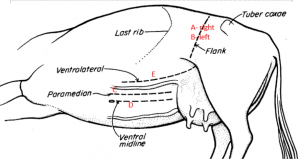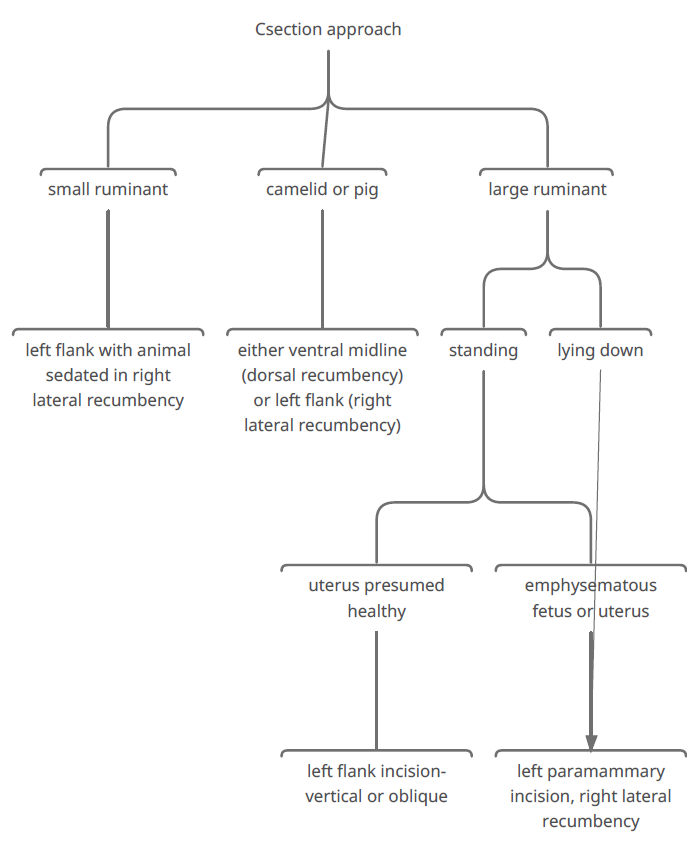Food/Fiber Cesarean Sections
Other approaches and species
Other situations

If the cow has been in dystocia for a prolonged period of time (definition of prolonged varies by parity and by environmental temperature), recumbent csection is likely and you should just plan to perform the csection with the cow lying down. Many times the uterus is not healthy and pulling it to a flank incision can rupture it. A paramammary (ventrolateral, marcenac) approach in the recumbent cow is most useful as the incision is directly over the uterus and manipulation is minimal. See E in the picture.
Youtube video– demo of paramammary incision approach. Their incision is much smaller than the one I usually make.
If the calf is a fetal monster, fetotomy can be performed via the Csection incision. This will make it easier to fit it through the incision.
Elective Csection
Double muscled breeds (Belgian Blue, Charolais, etc) have higher levels of dystocia due to the larger hindquarters of the calf. Veterinarians may be asked to perform elective Csection.
The best indicator of readiness for Csection is cervical dilation. However, calves within 2 weeks of their due date will usually survive. To ensure maturity of the calf, dexamethasone (20-30 mg im) should be given to the cow 24 hours prior to anticipated calving or Csection. A combination of prostaglandin and dexamethasone is often used to induce calving while improving lung maturation. Labor usually starts in 24-72 hours.
Other species
A flank incision in the recumbent animal is typically used in small ruminants. Heavy sedation is preferred over general anesthesia due to the risk to the babies of GA. Note that goat babies can hide very well; extra attention needs to be taken with checking to make sure all are removed.
Increased survival of goat kids was obtained when goats were sedated with a narcotic (butorphanol or methadone) and a benzodiazepine and given oxygen via facemask as compared to when they were placed fully under general anesthesia (intubated, placed in inhalant anesthesia).
Relative risk was 1.4 and odds ratio was 4.7
Sedated cesarean sections are associated with increased kid survival compared to general anesthesia in goats: retrospective cohort of 45 cases (2011–2021). JAVMA | MARCH 2023 | VOL 261 | NO. 3
Camelid csections can be either flank or ventral midline, depending upon your anesthesia options and personnel availability. No need to grab a hindlimb, any body part will do.
Csections are rarely performed in production swine but can be needed in pet pigs. Porcine Csections are typically performed under epidural anesthesia with light sedation. Acepromazine may be used if the sow is agitated. Isoflurane gas anesthesia can be administered via face mask but this does carry increased exposure risks for nearby personnel. Several incisional options exist as the uterus is highly mobile. Flank incision, paramammary or ventral midline incisions are all potential options. The easiest is the ventrolateral or paramammary approach as it allows the pig to be in lateral recumbency. The upper limb is abducted an incision made just dorsal to the mammary chain. Both horns can usually be exteriorized via this approach. An incision is made into the uterus near the uterine body and piglets removed. Additional incisions into the uterus can be made if necessary. The uterus is typically closed in a double layer inverting pattern with 0 or 1 absorbable suture. Prognosis is generally good for survival and fair to good for future fertility. See images
Review
Malone’s decision making flow chart – downloadable Csection approach mindmap
Resources
Goplen Csection ppt– sm ruminant
Trent Csection notes-covers a variety of species
Complications and outcomes of swine that underwent cesarean section for resolution of dystocia: 110 cases
(2013-2018). Veterinary Surgery. 2021;50:38–43.
Detailed Csection hints and techniques, 2008 IJVS – nice details for breech, torsions etc. Good reference
Induction of parturition in cattle, September 2006, Australian Veterinary Journal 84(9):312-6
A variety of Csections – youtube


